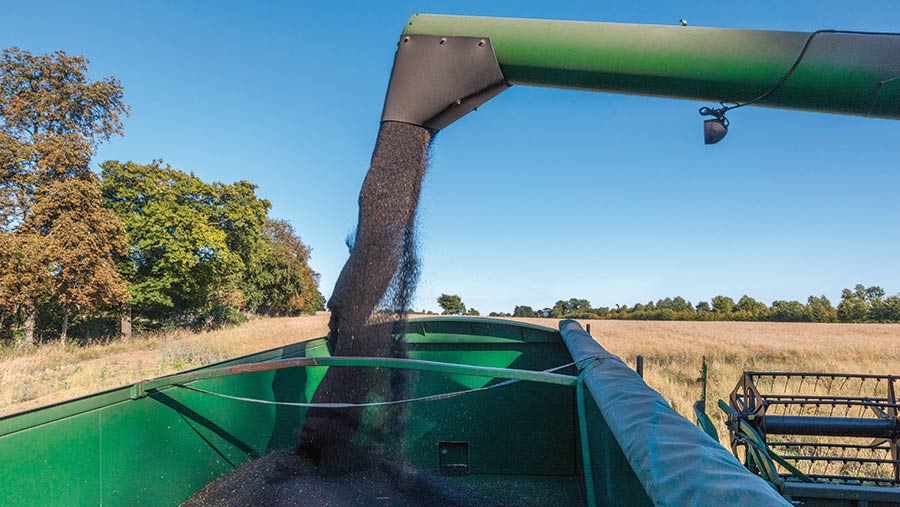Rapeseed crushers at risk without bigger UK crops
 © Tim Scrivener
© Tim Scrivener EU rapeseed production has fallen almost 30% in just five seasons, and progressively smaller crops mean the current structure of UK crushing is probably not sustainable, according to Martin Farrow, general manager of ADM Oilseeds.
Demand for rapeseed in the bloc is entirely driven by mandated biodiesel demand – more than 65% of all rape oil produced in the community is destined for the biodiesel market, he says.
UK rapeseed prices are currently the highest in the world and are at a six-year high for August, said Mr Farrow. However, the UK has a deficit.
See also: Coronavirus: Advice on farm staff safety and harvest labour
Rapeseed production
Reducing OSR production is a worldwide trend, with the global crop at about 48m tonnes in 2019, compared with 53m-54m tonnes just a few years ago.
The EU crop looks like coming in at less than 17m tonnes this year for the first time in many years and in 2015 was 24m-25m tonnes.
“UK production is miserable, said Mr Farrow, who puts it at probably lower than 1m tonnes and the lowest since 1989.
“The UK has demand for a 2m-tonne crop and the crushing industry is entirely set up for UK production – it’s not very good at importing. We don’t have the ability to bring in big vessels from Australia or Ukraine without transhipment at some point.”
Biodiesel demand has been seriously affected by the pandemic – it will increase, but the question is by how much, said Mr Farrow.
Wheat and maize record crops face demand uncertainties
The world is heading for a record wheat crop, although there are some risks in Europe and the Black Sea area, which, although it has had recent rain, has been very dry, International Grains Council analyst Amy Reynolds says.
There will also be ample opening stocks of wheat at the start of the new cereal year on 1 July, providing a buffer against crop problems in some regions.
However, more than half of those stocks are held in China (56%) and India, so are not readily available to the open market.
On the demand side, the requirement for wheat for animal feed will be down, because maize is so competitively priced.
With a record maize supply also forecast, the biggest question is on the demand side, said Ms Reynolds. Feed use is expected to increase. but industrial use levels are less certain.
Maize threat grows as bumper crop, coronavirus and politics interfere
While maize is already challenging wheat values, the threat will grow as the year progresses, warned Mr Eudall.
He illustrated this with current Ukrainian feed maize import values at £190/t for July delivery to a Yorkshire feed mill, compared with about £168/t for feed wheat delivered to the same mill.
Looking further forward, with no tariff on maize imports and new-crop available, Ukrainian maize for delivery to the same mill in September at £167/t is currently priced about £9/t cheaper than home-grown wheat.
Maize starch products are widely used in construction and the global economy faces an uncertain recovery rate from Covid-19.
Demand for maize as a feedstock for ethanol production has slumped as a result of lockdowns and is just starting to pick up slightly.
On the domestic front, milling wheat use in April at 450,000t showed a slight increase on the year, said AHDB senior analyst David Eudall.
Bread sales kept milling wheat demand underpinned during lockdown, and the market is telling growers to carry wheat forward because of the smaller expected crop in 2020, he said.
There’s also uncertainty over quality, and German milling wheat is increasingly competitive and setting the milling premium, which Mr Eudall expects will grow with the need to move milling wheat from the eastern UK production areas to north-west use areas.
Barley outlook dimmed by drinks demand but hopeful on exports
Demand for barley from the brewing, malting and distilling sectors is down nearly 100,000t on the year.
Even if pubs gardens open in July, it will be a slow recovery, with restricted demand for many months, if not for the whole of the next marketing season, said Mr Eudall.
This means a greater exportable surplus from a record spring crop area. However, there has already been a strong period of export sales into the EU for shipment between harvest and November to make best use of the trading window before the end of the UK’s EU transition period in its exit from the EU.
These experts were speaking at the Cereals LIVE event in 2020.
